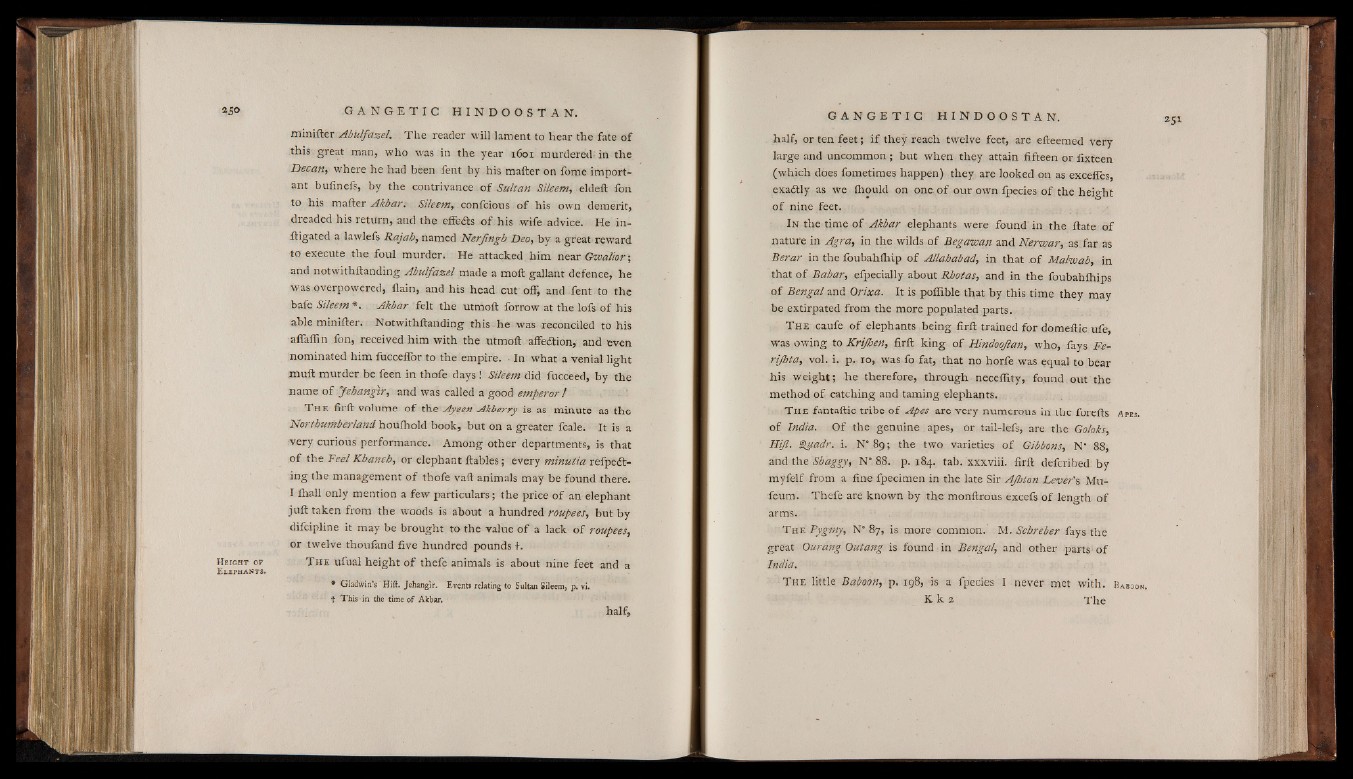
H eight of
E lephants.
minifter Abulfazel. The reader will lament to hear the fate of
this great man, who was in the year 1601 murdered, in the
Decan, where he had been fent by his mafter on fome important
bufinefs, by the contrivance o f Sultan Sileem, eldeft fon
to his mafter Akbar s Sileem, confcious o f his own demerit,
dreaded his return, and the effects of his wife advice. He in-
ftigated a lawlefs Rajah, named Nerjingb Deo, by a great reward
to execute the foul murder. He attacked him near Gwalior;
and notwithftanding Abulfazel made a moft gallant defence, he
wasoverpowered, flain, and his head cut off, and fent to the
bafq Sileem *. Akbar felt the utmoft forrow at the lofs of his
able minifter. Notwithftanding this he was reconciled to his
affaflin fon, received him with the utmoft affedtion, and even
nominated him fucceflor to the empire. • In what a venial light
.muft murder be feen in thofe days ! Sileem did fucceed, by the
name of Jebangtr, and was called a good emperor!
T h e firft volume of the Ayeen Akberry is as minute as the
Northumberland houihold book, but on a greater fcale. It is a
very curious performance. Among other departments, is that
of the Feel Kbaneb, or elephant ftables; every minutia refpedt-
ing the management o f thofe vaft animals may be found there.
I lhall only mention a few particulars; the price o f an elephant
juft taken from the woods is about a hundred roupees, but by
difcipline it may be brought to the value o f a lack of roupees,
or twelve thoufand five hundred pounds t.
T h e u fu a l h e i g h t o f th e f e a n im a ls is a b o u t n in e f e e t a n d a
* Gladwin’s Hift. Jehangir. Events relating to Sultan Sileem, p. vi.
t This • in the time of Akbar.
half,
half, or ten feet; i f they reach twelve feet, are efteemed very
large and uncommon; but when they attain fifteen or fixteen
(which does fometimes happen) they are looked 011 as exceffes,
exadtly as we ihould on one. o f our own fpecies o f the height
of nine feet.
In the time o f Akbar elephants were found' in the ftate of
nature in Agra, in the wilds o f Begawan and Nerwar, as far as
Berar in the foubahihip o f Allahabad, in that of Malwab, in
that of Babar, efpecially about Rbotas, and in the foubahihips
of Bengal and Orixa. It is poflible that by this time they may
be extirpated from the more populated parts.
T h e caufe o f elephants being firft trained for domeftic ufe,
was owing to Kri/ben, firft king of Hindooßan, who, fays Fe-
rißta, vol. i. p. 10, was fo fat, that no horfe was equal to bear
his weight; he therefore, through neceflity, found out the
method of catching and taming elephants.
T h e fantaftic tribe of Apes are very numerous in the forefts Apes.
of India. Of the genuine apes, or tail-lefs, are the Goloks,
Hiß. Suadr.. i. N°89; the two varieties of Gibbons, N“ 88,
and the Shaggy, N” 88. p. 184. tab. xxxviii. firft defcribed. by
myfelf from a fine fpecimen in the late Sir Aßiton Lever's Mu-
feum. Thefe are known by the monftrous excefs of length of
arms.
.T h e Pygmy, N* 87, is more common. M. Scbreber fays the
great Ourang Outang is found in Bengal, and other parts of
India.
T h e little Baboon, p. 198, -is a fpecies I never met with. Baboon.
K k a The